Part 2: Trapped!
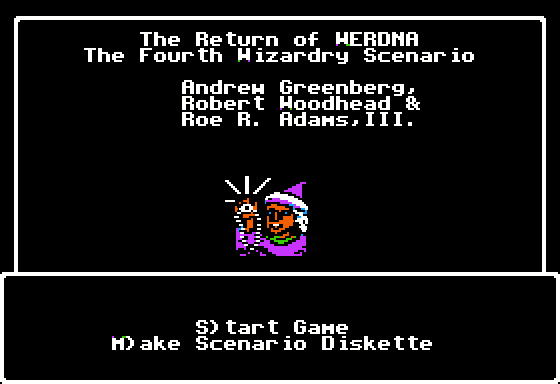
"See us? Any one of us might be the death of you!" As if in mockery, Wizardry IV's title screen introduces the different kinds of do-gooders you'll be facing throughout the game. Weak do-gooders and overpowered do-gooders, solo do-gooders and do-gooding groups... There have been eight classes in the first three Wizardry titles - Fighter, Mage, Priest, Thief, Bishop, Ninja, Lord, and Samurai - and they're all present in the fourth scenario, with different character models to distinguish just what and how strong they are or even what weapon they wield (hence the infamous Blade Cusinart' among the title screen images). On top of that, some boss encounters have their own, unique looks, to be shown off in the LP.
Interestingly, Wizardry IV was originally advertised as graphically an improvement over the previous Wizardry titles. More graphics, more plot and more adventure than any previous Wizardry scenario, the back of the box proudly proclaimed. Well, the character models do look pretty good, I dare say. That, however, is the only element to the game that can even be called "graphical." The rest are, of course, the wireframe dungeons we all know and love.
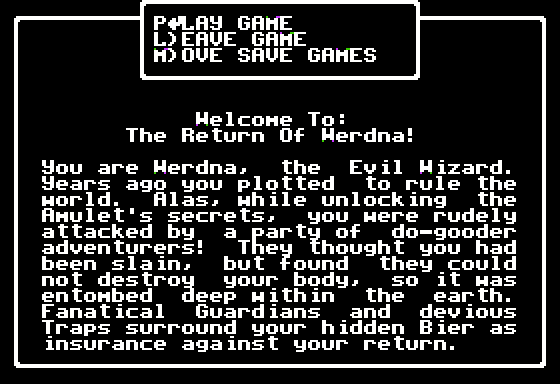
The next screen recaps the basics of Werdna's backstory that you should already be familiar with from the OP. Basically, you were killed, but not quite, and now you awaken on the lowest floor of your 10-floor prison and want to reclaim the all-powerful amulet that had been stolen (back) from you.
Your ultimate goal? World domination, of course!
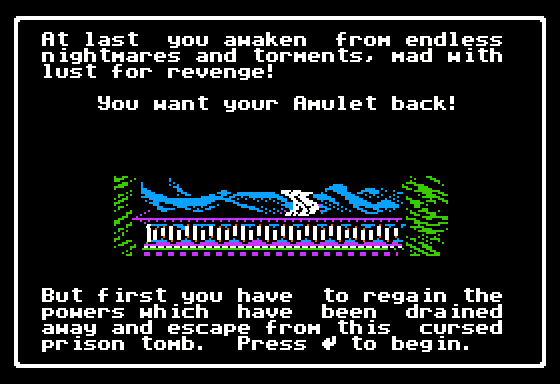
Werdna's awake, true, but even staying alive will prove troublesome for him, not to speak of regaining the lost powers, which will only happen a looong way down from here.
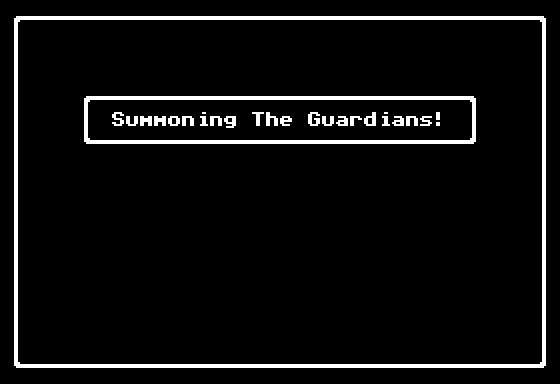
Summoning The Guardians! -- Laying Out Patrol Areas! -- Setting Up The Traps!
Whenever you enter a new level, restart or reload the game, the current floor gets reset, and its guardians promptly respawn. The guardians include not just all the do-gooders that roam the floor, but also a number of fixed encounters that guard specific passages or puzzle-related items. Since you can only save when quitting the game, that means Wizardry IV punishes you for saving and tries its best to prevent you from save-scumming. On the other hand, saving the game and thereby resetting the level has one important benefit -- it pushes Trebor's ghost away from you, a much needed thing at times, even at the cost of having to fight through the adventurer hordes again.
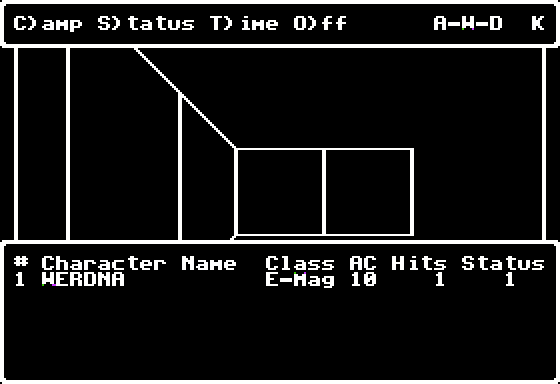
And so it begins.
Your line of sight is really limited in Wizardry IV. Basically, you can only see the walls and places of interest located no farther than two squares in front and one square to the side of you. Hence the apparent absence of a wall to your right when in fact you start out in a closed off 4x4 room.
To add insult to injury, the annoying Status window won't even let you see the floor. It may show the current party composition, the character's class, AC, HP and status (poisoned, turned to stone and the like), but it's also way too huge and makes finding your way around much harder.
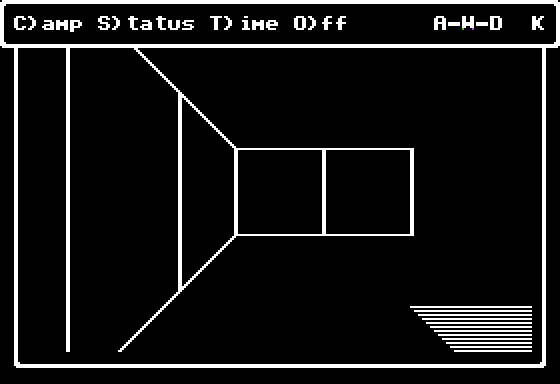
Good thing it can be turned off by pressing S, then. Which is the first thing you should do when you start playing the game. It's not like you really need that screen anyway.
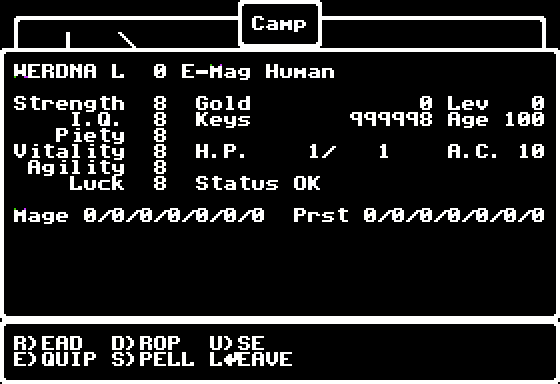
Pressing C brings up the Camp screen. It also pauses the game -- a crucial thing, what with Trebor's ghost pursuing you in real time.
His powers completely drained from him, Werdna is at the moment a level 0 human Mage of evil alignment. His starting statistics are all 8s, but that doesn't really matter the way it would in any of the previous (or later) Wizardry games. In Wizardry IV, there is no attribute point allocation or anything. A level-up will always improve Werdna's attributes by 1 and give him access to a new tier of Mage spells, of which he cannot currently cast any. Being a Mage, Werdna won't be learning Priest spells at all, despite them being present on the screen, so having monsters able to cast Priest spells among those you summon is going to be extremely important in the course of the game.
One particularly notable thing on the character screen is the Keys stat -- this is the number of keystrokes you're given to beat the game. When it reaches zero, the game ends. Be aware that Wizardry IV even takes invalid keypresses into account, so no matter what key on your keyboard you press, it brings you one step closer to a game over. Thankfully, the keystroke limit is fairly generous, so you shouldn't really run into any troubles with it in a regular play through.
Per D&D, of which the rules Wizardry uses are derivative, the lower a character's AC, or armor class, the better; it should come as no surprise, then, that Werdna's starting AC is the highest one possible.
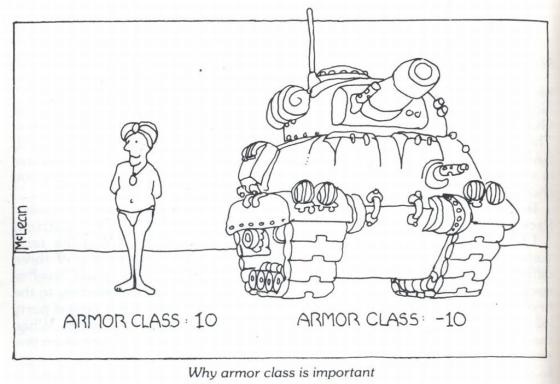
The picture above, taken from the Wizardry I manual, should give you an idea.
Werdna can lower his AC by equipping the kind of stuff a Mage can equip as well as through some of the spells his allies can cast on him during combat.
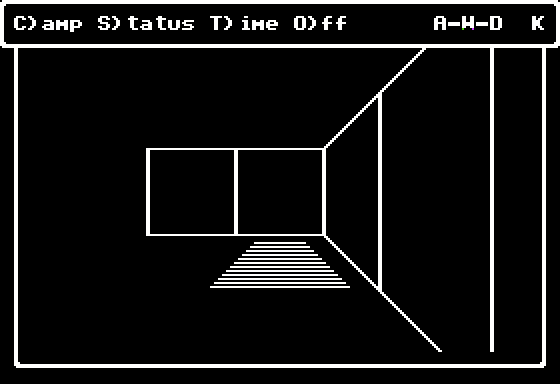
What you see in front of you in the above screenshot is an "event" square. In a minimalistic and abstract kind of game that is Wizardry IV, all event squares look the same, no matter what kind of event is supposed to take place there -- a fixed encounter, a message, a summoning pentagram, an NPC, or even a trap.
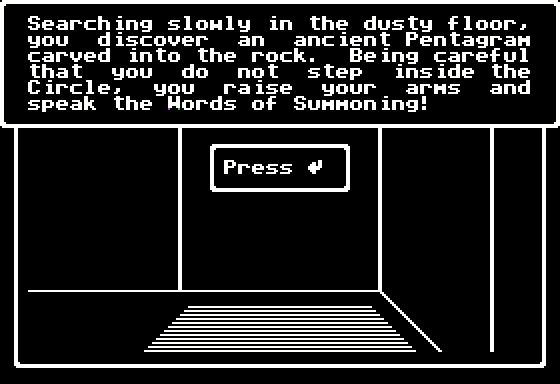
In this particular case, the event square is a pentagram -- really helpful given that you start out alone and at 1 HP, and woe to you if you hit a random encounter before you get your first monsters!
(The game is certainly very hard as it is, but the reason why Werdna's jailers would leave all these pentagrams inside the prison dungeon, including one just two steps away from his coffin, is beyond me.)
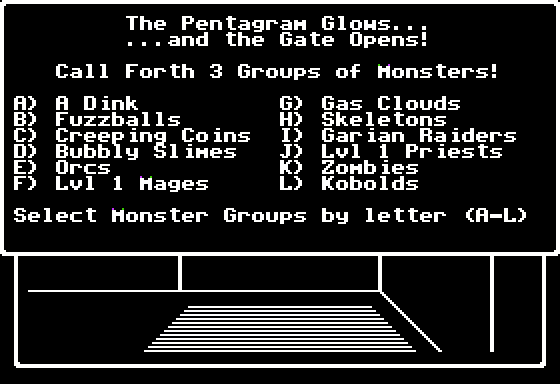
Now bear with me.
Whenever Werdna arrives at a pentagram, he regains a fraction of his lost power. He goes up one level, accesses another tier of Mage spells, gains 10 HP, and improves all his attributes by one point. But most importantly, pentagrams are summoning gates. At a pentagram, Werdna can call forth three different groups of monsters to fight at his side. (Remember how you faced Werdna accompanied by up to three groups of vampires in Wizardry I's endgame? Things are the other way around now.) The list of monsters differs from floor to floor, and the higher you climb, the stronger monsters you can summon.
The monsters come from the previous Wizardry games, which has nothing to do with a lack of imagination in the developers, but rather with the fact that assuming an intimate familiarity with Wizardry I to III is just what Wizardry IV does, or even the very principle on which it is based. A Dink is a dwarf first introduced in Wizardry II who always appeared alone and went by the name of Little Old Man when unidentified. Given that you can only summon no more than one Dink, that it has a whopping 3 HP and that it can only attack for 1 point of damage once per turn, it looks totally worthless -- and indeed it is for the most part. However, in The Return of Werdna, A Dink is a special, very special kind of monster, it's just that its significance will only become apparent much later, in one of those dick moves this game is so full of. Fuzzballs also made their first appearance in Wizardry II, notable for the fact they didn't attack you. Instead, all they did was call for help so that more and more Fuzzballs arrived... Nothing was changed about them for Wizardry IV, so there's no point in summoning them. Creeping Coins are okay, actually, and worth summoning despite only having 1 HP. They always come in groups of nine, and similar to Fuzzballs in that they can call for help - except they can also deal minor damage on top of that, both in melee and with their breath attack that targets the entire enemy party and almost always hits for 1 HP. Bubbly Slimes are exactly as pathetic as Slimes tend to be. (By the way, did you know Wizardry I was the first cRPG to introduce Slimes? It was only afterwards that they migrated to JRPGs thanks to Yuji Horii's love for the game.) Technically, their attack can inflict poison, but from what I've seen that happens too rarely to really matter. Orcs are pretty decent albeit standard lvl1 creatures. They come in groups of 3 to 6 depending on the roll of a die, attack for 1D4, and have 1 to 4 HP. Lvl 1 Mages are exactly as frail as you would expect them to be. They know a couple of useful spells that I'll elaborate upon when describing Werdna's own spell list, but why have them when Werdna himself is a Mage?
Next, Gas Clouds are probably my favorite of the bunch. These magical creatures have decent HP, get summoned in groups of 2 to 8, but most importantly they can cast Mage spells of both 1st and 2nd tiers while their regular attack can inflict paralysis -- and a paralyzed character is as good as dead. Skeletons are the simplest of the undead. They're stronger than Orcs, but being undead they're susceptible to being dispelled by enemy Priests. From what I can tell, it doesn't really happen too often; it really sucks when it does, though. And as far as the undead go, Zombies are definitely a better choice. Not only do they have 2 to 11 HP, but they can also paralyze by touch. Summoning them is risky, but on the other hand well worth the risk. Garian Raiders are melee-only warriors from Wizardry III, pretty average in every way. They might be a decent choice for those not willing to take the risk of traveling with the undead maybe. Kobolds are also pure fighters. You may remember them from back when you were exploring the first floor of the mad overlord's dungeon, but they're plain unremarkable otherwise. Finally, Lvl 1 Priests are without a doubt the most essential creatures on that list, and not just because Werdna's going to rely on them for healing, but mostly because they're directly tied into the game's very first puzzle -- as we're about to see.

Given all that, summoning Gas Clouds and Lvl 1 Priests is pretty much a given. In a bout of eccentricity, I also decided to go for Orcs instead of Zombies this time, for no particular reason except wanting to be a unique snowflake. The walkthrough I checked when preparing this update to make sure I don't miss out on anything assured me the best combination of monsters to summon would be Zombies, Creeping Coins and Lvl 1 Priests. That does indeed seem to be the best possible combo, even though I'm pretty sure I didn't find Creeping Coins to be particularly efficient in my last playthrough.

You can approach a given pentagram as many times as you want, and it will restore your HP and spell points every time as well as make you re-summon all the monsters again. There may be a limit to how many times a single pentagram can restore your spell points, but I'm not too sure about that.
As a matter of fact, re-summoning monsters is often mandatory. True to its D&D roots, Wizardry is essentially a roll-playing game. The amount of monsters that get summoned is randomized, and you just won't be able to get far with too few of them. So we re-roll until the number of monsters summoned suits us. I won't always be aiming for the highest number of monsters possible, but generally the more monsters, the better are your chances of survival.
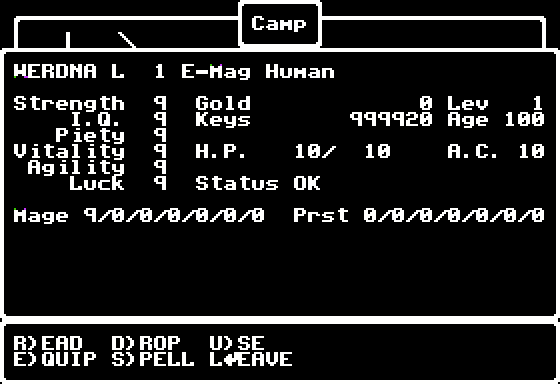
On the Camp screen, we can see Werdna's now improved stats. Note that for each tier of Mage spells he gets access to, Werdna automatically has 9 spell points, which is the maximum but still not too many, so they should be managed carefully.
Pressing S for Spell, we access the spell book. It lists all the Mage spells there are, but naturally we can't cast them all yet.
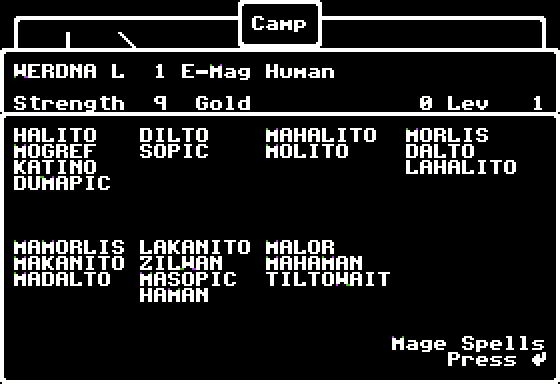
I will be explaining the spells as we access them, but if you're feeling impatient you can consult the Mage Spell Chart in the "Extras" section of the OP.
Currently, Werdna can only cast the 4 most basic spells. Halito, or Little Fire, is the rudimentary fireball spell that causes a flame ball the size of a baseball to hit a single opponent for 1d8 points of damage. In Wizardry I, it was basically your Mage's base attack, and just like in the first scenario, in Wizardry IV it won't be of much use to you past the early game. Ceteris paribus, that spell charge is better spent on Katino, the mass target spell that attempts to put the entire enemy party to sleep by turning the air surrounding them into miasmatic "bad air". Note that Katino targets a group of monsters; note further that your own party counts as three groups and the enemy, adventuring party, being your normal Wizardry party, counts as one group. That means your Katino affects all the enemies, whereas their Katino only affects a relatively small part of your monstrous gang.
Next, Dumapic, the Clarity spell, gives your location on the current dungeon floor relative to (0,0) as well as the direction you're facing. This spell is extremely useful for mapping -- naturally, Wizardry IV doesn't have an automap, assuming instead that the player will be mapping out the dungeon on graph paper. It won't be of much use to us in this LP, though, since I already know my way around full well. To the first time player, however, it is highly essential. The last of the four spells, Mogref, also known as Body Iron, reduces the caster's AC by 2 for the duration of the encounter. Even so, AC of 8 isn't that much better than 10 AC, so you're better off relying on your spell-casting allies to lower your AC instead of wasting time and spell points on Mogref.
We also have Gas Clouds in our party, with the 2nd tier spells available to them. Dilto causes the enemy group to be enveloped in darkness, which raises their AC and thus reduces their ability to defend against your attacks. Sopic, or Glass, causes the caster to become transparent and lowers their armor class by 4. Given that there are only two tier 2 spells in Wizardry I to IV and none of them is particularly strong or imaginative, it should come as no surprise that later Wizardry V significantly expanded this tier by adding a stoning spell, a group lightning attack spell, an unlock spell, and a speed up spell to this list.

The 4x4 room that you start in has no apparent way out. There is a way out, of course, but to discover it, you have to get really creative.
First thing we do (after having summoned the 1st Lvl Priests) is wander aimlessly around the room waiting for a random encounter to pop up.
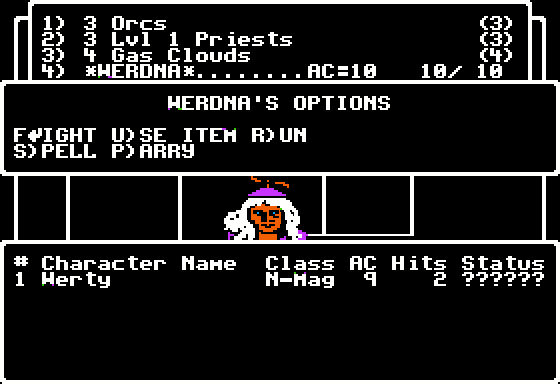
Luckily, our first encounter is against a neutral Mage named Werty who only has 2 HP. Should be a piece of cake.
In combat, you only control Werdna directly. "Fight" makes him attempt a melee attack, and the other options should be self-explanatory. As for the monsters, you can't just order them around; instead, they do whatever dice rolls tell them to, and it is indeed as frustrating as it sounds.

After we've chosen a combat option for Werdna, the game takes us to a screen where we must confirm it or take it back. Once we've confirmed it, and only after that, the game rolls for the opponent's action. In this case, Werty has decided to cast a Halito. Naturally, an opponent's spell can target any group in our party, including Werdna himself.
Halito only hits for 1-8 points, however, so even if it targeted and hit Werdna, it couldn't kill him outright anyway...
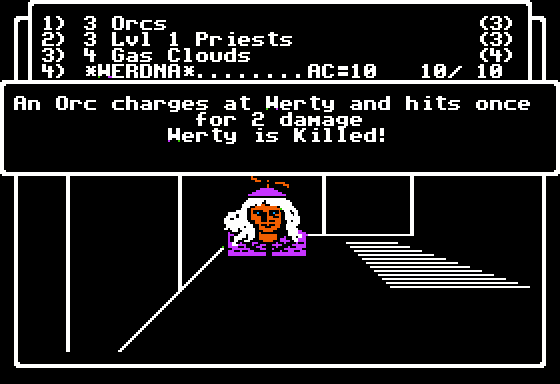
...on the other hand, killing a squishy 2HP Mage isn't that hard.

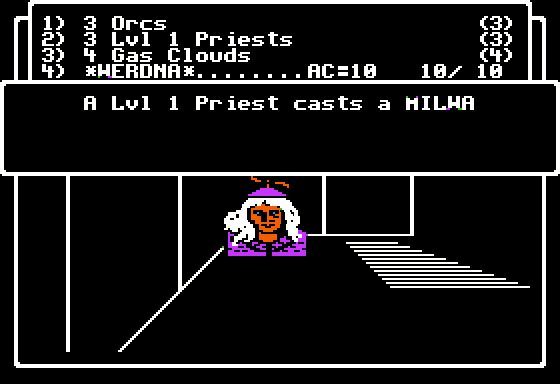
Back to the topic of getting out of the starting room: in an encounter, wait for one of your Priests to cast Milwa, the 1st tier Light spell. That is the key to escaping.
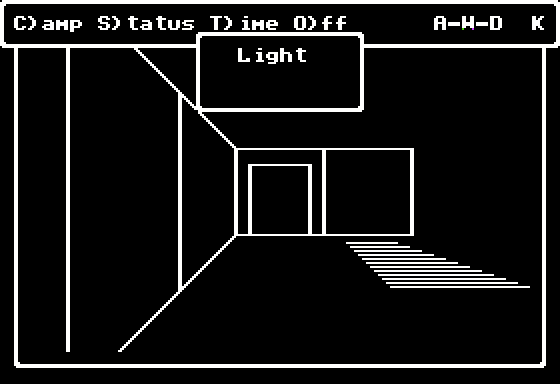
A Milwa lasts even when out of combat, and with its help, you can finally discover a secret door leading out of the room! (Incidentally, that means you can only enter a secret door you see. No random bumping into walls in search of a door for you.)
To sum it up, this is what Wizardry IV's infamous first puzzle consists in: summon a group of Lvl 1 Priests -- wait for an encounter -- wait until a Priest casts Milwa; if he doesn't, wait for the next encounter, etc.
That, naturally, is the only way you can get out of the starting room. The rationale behind the puzzle being probably as follows: it is only natural to assume there has to be a way out of the starting room -- otherwise what would be the point of the game? On the other hand, any experienced Wizardry player knows that, being a Mage, there is no way for Werdna himself to cast Milwa, as well as that you can only see (and enter) secret doors with light on. From all that, it follows that if you can't, then someone in your party should be able to cast Milwa, so summoning a group of Priests is the logical next step. Finally, you can't just order the Priests to cast a Milwa since you don't control them directly, so you should wait for them to cast it in combat when they feel like it.
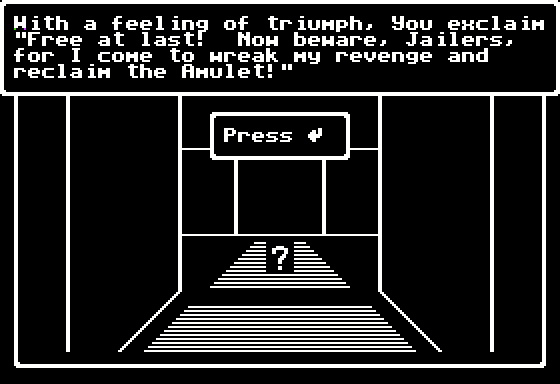
Freedom and revenge at last!
Well, not really. We still have a long way to go. And first we must make our way through and out of the Pyramid of Entrapment, coming up next on Wizardry IV!
P.S. The question mark in the last screenshot is a unique wandering NPC that you must "catch" to trigger an encounter. I'll be sure to do just that as soon as I can.